
3 Professional Fixes for Your Frizzy Hair
Flowing, glossy, and luxurious. These are all adjectives that have often been used to describe the well-kept locks of famous figureheads. Believe it or not, some people’s fame has been boosted by simply having fabulous hair. Notable faces like Farrah Fawcett, Diana Ross, and Kate Middleton are just some of these people who have been blessed with glorious manes.
However, not all of us are fortunate enough to revel in bouncy curls. But why is that so? Although some of us use high-end products or follow the cult regimes popularised by blogs, we may still experience this phenomenon called frizz. So what is frizz and how can we keep it at bay? Let’s take a look at what it is, some causes, and some possible solutions.
What is Frizzy Hair?
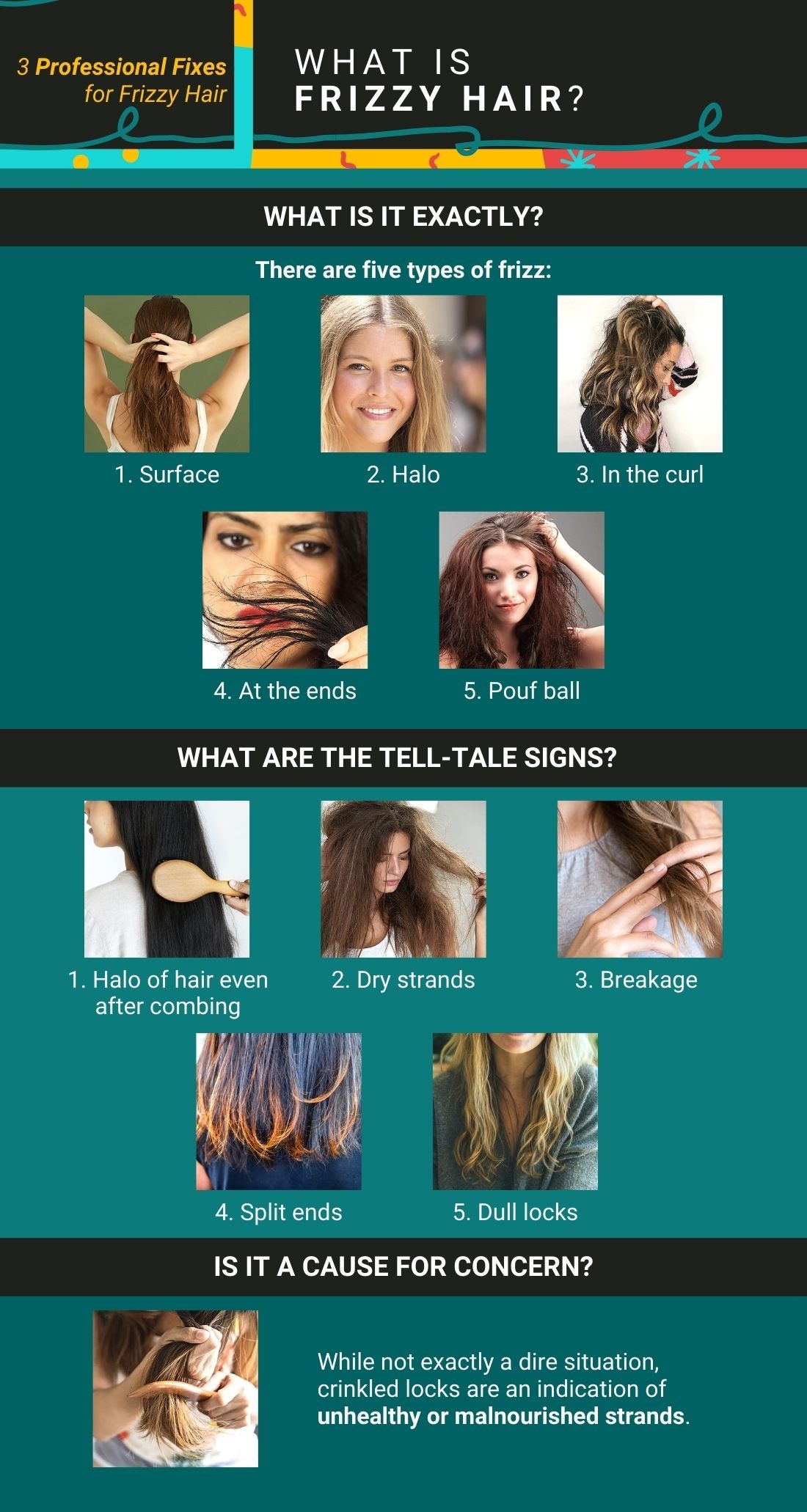
When it comes to the crowning glory, there is a common misconception that curly equates to frizzy. However, whether straight, wavy, or curly, any hair type can become wiry, although it is more common for individuals who have curls. But this is only because curly locks are naturally drier than straight or wavy ones.
1. What Is It Exactly?
Frizz is described as the strands that tend to stick out from your tresses or at the top of your head. There are five types of frizz:
- Surface: Only appears on the exterior of your locks
- Halo: Surrounds your crown area
- In the curl: Exists inside your tresses
- At the ends: Dry, straw-like ends
- Pouf ball: Exists throughout your strands and on the surface
2. What Are The Tell-Tale Signs?
We all have bad hair days, but how do you differentiate a bad hair day from damaged and crinkly tresses? If you’ve started realising that you are suffering from a chronic case of bad hair days, you might actually have frizzy locks. Some obvious signs of this condition include:
- Halo of hair even after combing
- Dry strands
- Breakage
- Split ends
- Dull locks
3. Is It A Cause for Concern?
While not exactly a dire situation, crinkled locks are an indication of unhealthy or malnourished strands. Flyaways are normal, as mentioned above, but this issue can leave you with a halo of crinkly hair, which can make you look unkempt. Additionally, if not treated, you end up with dry tresses that lack lustre and have split ends. Split ends are particularly nasty as they can travel up the shaft of the strand and cause further damage. Finally, weak hair cannot withstand many great salon treatments such as perming and colouring.
6 Causes of Frizziness
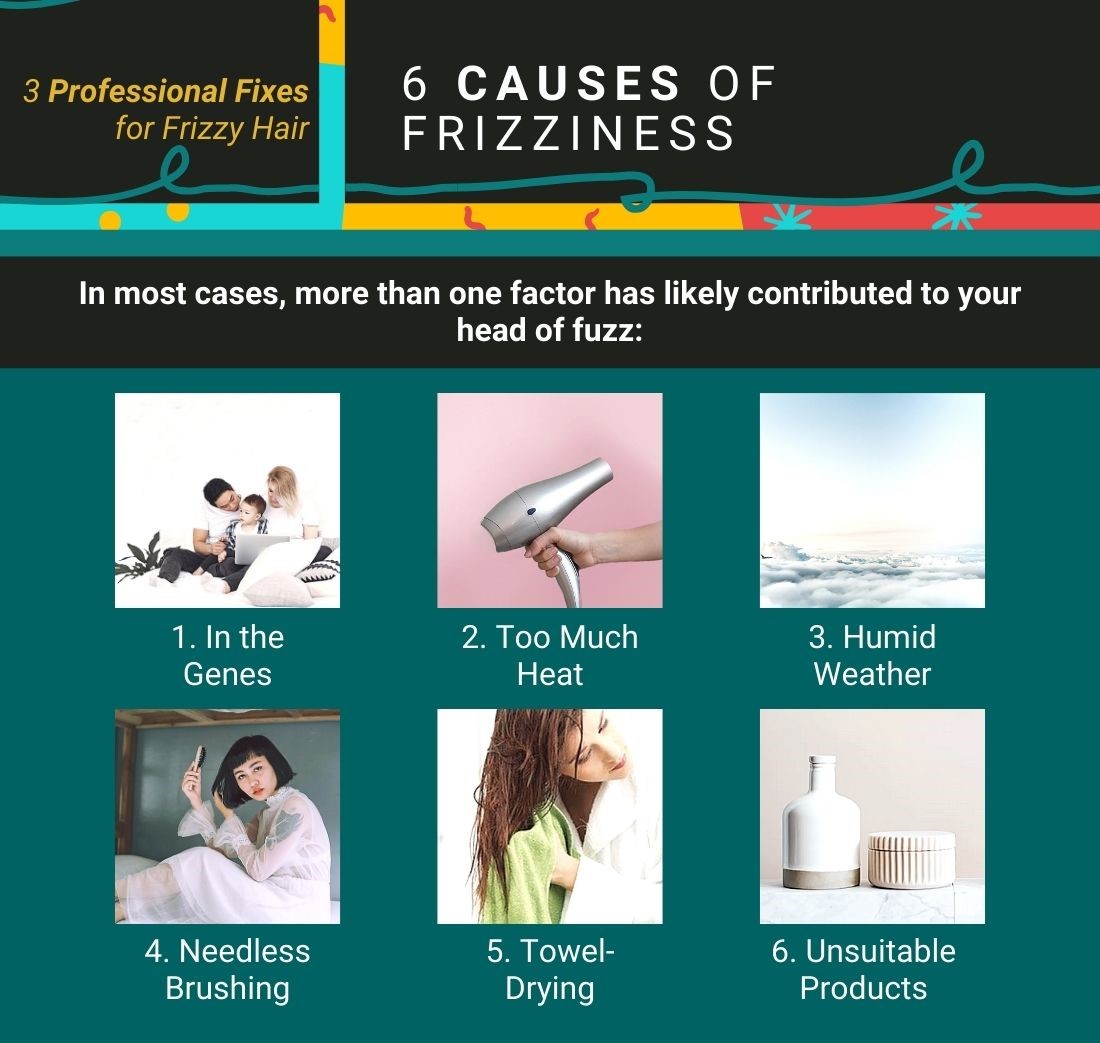
In most cases, more than one factor has likely contributed to your head of fuzz. The main cause of the condition, though, usually lies with your roots. Frizz occurs when cuticles on the external layer of the shaft of your strands are raised or agitated.
Ordinarily, these cuticles lie flat in most hair types. However, as curlier locks are drier, they tend to be more partial to developing these bristles.
Here are six reasons that could be adding to this hair-raising situation:
1. In the Genes
So far, we have mentioned that individuals with spiralling tresses are generally more predisposed to this condition. This tendency is due to their genetic makeup, which determines the type of tresses they have. Flat follicles in strands mean you likely have waves or curls, whereas rounded follicles mean you likely have straight tresses.
2. Too Much Heat
An excessive use of heat tools such as flat or curling irons and blow dryers are very harmful. And while a hot shower is like a hug, likewise, it is also extremely damaging to your natural tresses. Continuously applying heat to your locks strips them and your scalp of both moisture and natural oils, resulting in damaged and straw-like strands.
3. Humid Weather
One factor that is not in your control, is the weather. Humidity is the biggest enemy of smooth and healthy locks. In humid air, hydrogen levels are higher, and they bond with water and protein in the strands, resulting in a bristly and wiry crowning glory.
4. Needless Brushing
An old wives’ tale tells us to brush our locks with 100 strokes a day to get them strong and shiny. Unfortunately, that is a myth. Detangling before washing them helps aid in product distribution. But once your hair has dried, excessive brushing could rough up the exterior layer of your strands, resulting in frizz. It could also stretch the strands, leading to breakage.
5. Towel-Drying
No one wants to drip water all over their floors, and most of us use towels to massage our scalps and dry our locks. Alas, if your towel is made from the wrong fabric, drying your hair with it can lead to crimped and kinky strands. Wet tresses are extremely fragile. Rubbing at your head vigorously, in general, also leads to irritation of cuticles, causing them to rise.
6. Unsuitable Products
If your products have alcohol, harmful ingredients, or just aren’t suited to the needs of your tresses, you will likely end up with crinkled and damaged locks. Some of these ingredients, especially alcohol, may be too strong for your crowning glory and end up doing the opposite of keeping them smooth and shiny — stripping them of moisture and natural oils.
Option 1: Rebonding
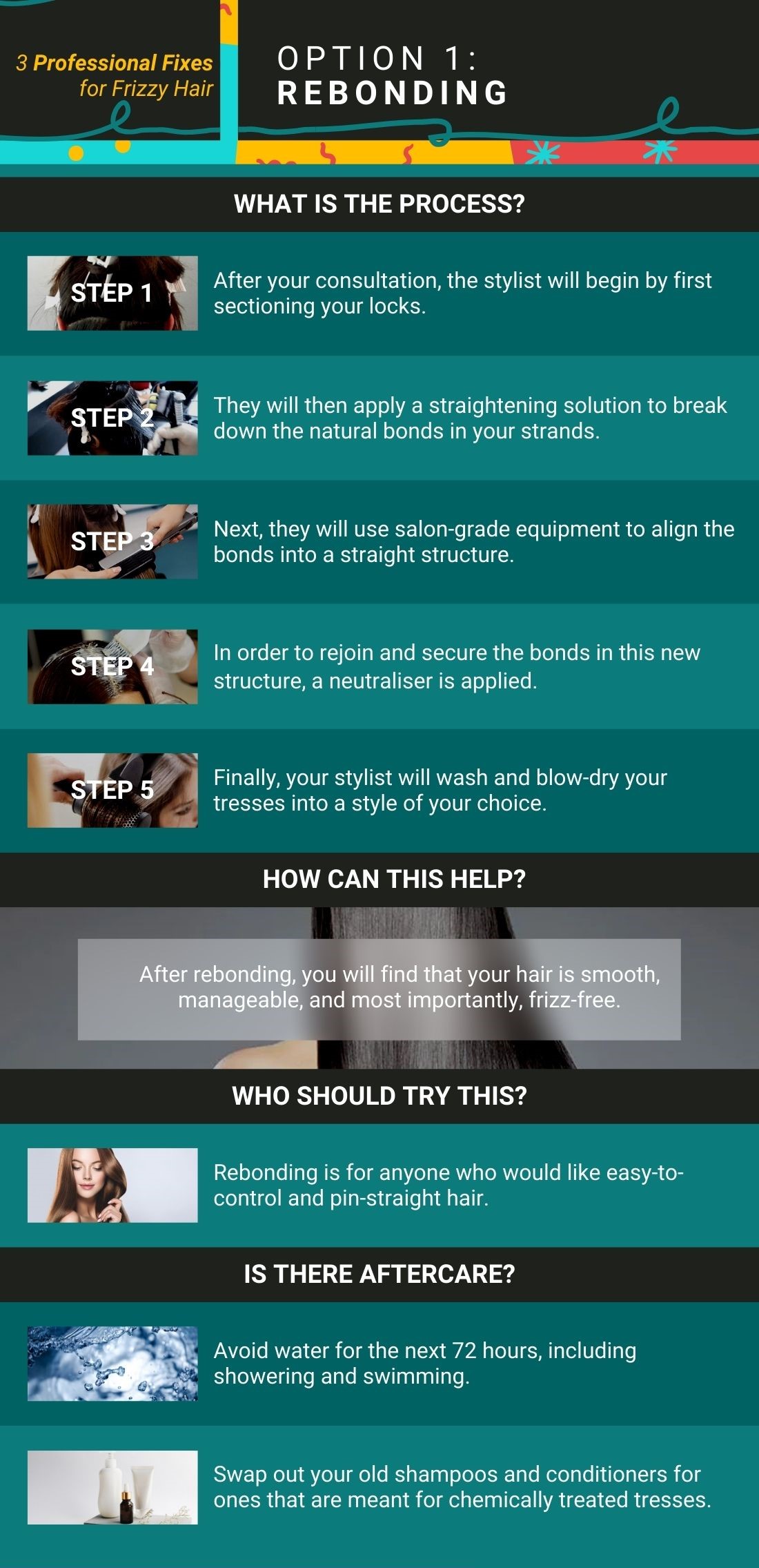
A Japanese treatment that reached the shores of Singapore in the early 2000s, rebonding is a technique whereby an individual’s crowning glory is straightened for a long period of time.
1. What is The Process?
Once you have consulted with your stylists, you will come in to treat your hair. Note that it can be a fairly long process, depending on the length and condition of your locks. It’s advisable to bring along snacks, a portable charger, and to wear loose clothing. The stylist will begin by first sectioning your locks, before they break down the natural bonds in your strands. This can be achieved by applying a straightening solution to them evenly. Next, they will use salon-grade equipment to align the bonds into a straight structure. In order to rejoin and secure the bonds in this new structure, a neutraliser is applied. Finally, your stylist will wash and blow-dry your tresses into a style of your choice.
2. How Can This Help?
Rebonding is an excellent choice to help manage your strays. Once you have completed this treatment, you will find that your hair is smooth, manageable, and most importantly, frizz-free. And of course, it all depends on how well you care for your tresses and their natural structure. Other benefits include:
- Easy to manage
- Eliminates use of heat tools
- Stylish without needing to style
- Professional and sleek
- New growth is unaffected by the chemicals used
3. Who Should Try This?
Rebonding is for anyone who would like easy-to-control and pin-straight hair. It is especially an ideal option for individuals who suffer from high levels of frizz, as well as those with minimal hair damage. This technique smoothes out all kinks and leaves you with sleek and shiny locks. People who want to minimise styling and accessorising should also consider this look.
4. Is There Aftercare?
Absolutely! A key recommendation is to avoid water for the next 72 hours. That means no swimming or washing. As your sensitive tresses have undergone a chemical treatment, you may be required to rehaul your entire hair care routine. Swap out your old shampoos and conditioners for highly nourishing ones that are meant for chemically treated tresses. Lastly, check with your expert stylist on specific aftercare tips to follow once you step out of the salon — doing so, will help prolong the stunning effects of this procedure.
Option 2: Defrizzing Treatment
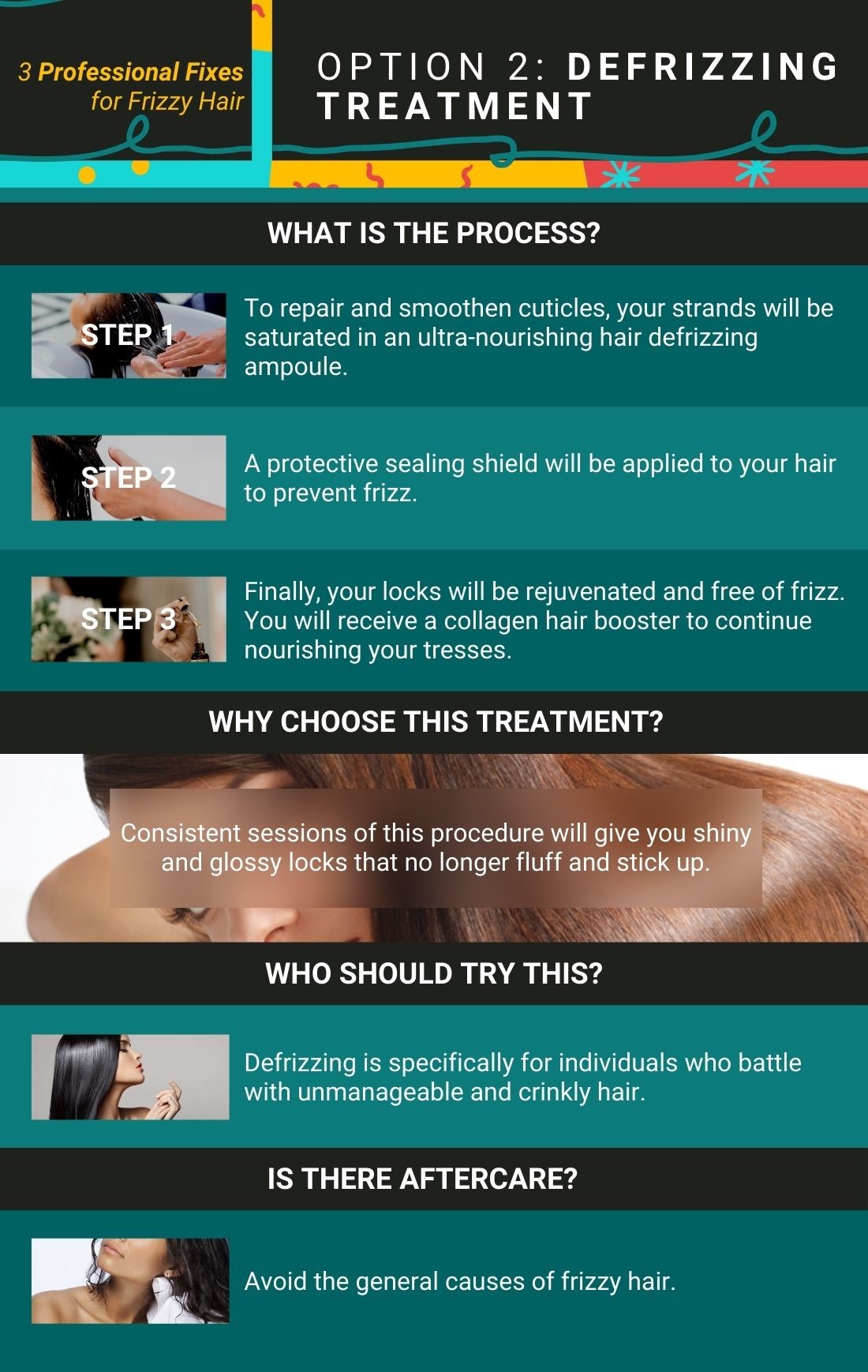
An alternative option would be a defrizzing treatment. It aims to enhance your natural strands and eliminate any unnecessary curls. A good defrizzing procedure should also look to tackle malnourished strands and protect them. Let’s take a look at how it works.
1. What Is The Process?
After your pre-appointment, you have most likely decided on your treatment and set a date. Your stylist will first saturate your tresses in an ultra-nourishing hair defrizzing ampoule to repair cuticles as well as restore and strengthen them. Your stylist then coat your strands with a protective sealing shield to lock in the nutrients from the defrizzing solution. Finally, your hair will be styled according to your preference.
2. Why Choose This Treatment?
This procedure will give you shiny and glossy locks that no longer fluff and stick up (especially on those really humid days!). One plus point of this method is that it tackles the problem at its roots — literally! The health of your hair’s roots are relative to the health of your tresses. This process strengthens roots to ensure your locks grow out shiny, strong, and sleek.
3. Who Should Try This?
Unlike rebonding, defrizzing is specifically for individuals who battle with unmanageable and crinkly hair. The products employed in the process focus on taming difficult and crinkly tresses. Should you be unsure if you fit the bill, speak to a stylist and book a consultation session. Allow the experts to identify the necessary treatments for you.
4. Is There Aftercare?
You should avoid the general causes of frizzy hair, such as excessive use of heat tools and towel-drying your hair. Should you be concerned about the products you are currently using, speak with the professionals at the salon. Our highly trained hair experts can provide you with advice from working with your individual locks.
Option 3: Hair Regrowth Treatment
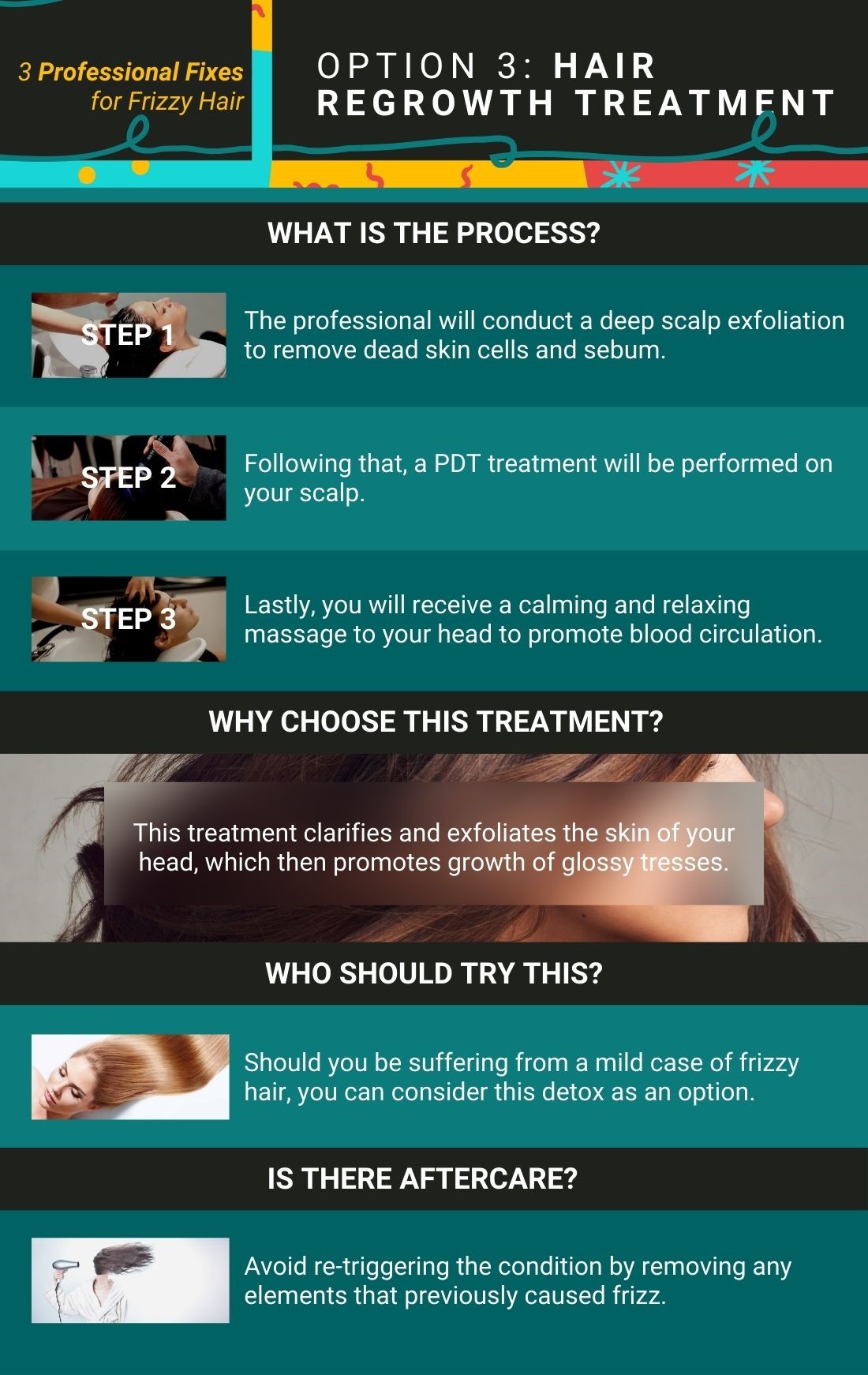
The third and final option is a hair regrowth treatment. A non-conventional option that mainly targets scalp health and strand regrowth, this treatment does reap incredible benefits for hair health.
1. What Is The Process?
If you have decided on this treatment, the professional will conduct a deep scalp exfoliation to remove any debris built up by dead skin cells and sebum. Following that, a PDT treatment will be performed on your scalp. This service will assist in balancing the pH levels of your scalp, nourishing it, and invigorate growth. Lastly, you will receive a calming and relaxing massage to your head to promote blood circulation.
2. Why Choose This Treatment?
While not directed at fighting crinkly hair, this treatment clarifies and exfoliates the skin of your head, which then promotes growth of glossy tresses. Any damaged hair can be cut off, leaving you with shiny, strong, and healthy hair.
3. Who Should Try This?
One essential thing to note is that this process is generally meant to boost the health of the head by exfoliating, moisturising, and unclogging follicles. However, attending to the root of your strands can also promote healthier growth and shine. Should you be suffering from a mild case of frizzy hair, you can consider this detox as an option.
4. Is There Aftercare?
Similar to defrizzing, you should ensure you avoid re-triggering the condition by removing any elements that previously caused frizz. You should also apply scalp boosters to help extend the effectiveness of this method.
The Final Takeaway
While there are many causes for frizzy and unruly hair, there are also professional fixes such as these that can assist in managing or eliminating it. As for all treatments, you should always ensure you have sought the opinion of a trained specialist to understand the condition of your tresses and learn how to care for them.
Remember, naturally, our bodies go through many changes, and this affects your scalp and roots. Aside from avoiding the aggressors that cause frizziness, consistency, and aftercare are key to maintaining your glorious locks!


